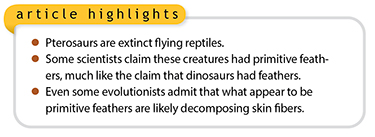 Evolutionary scientists have recently claimed that pterosaurs had feathers.1 Pterosaurs were winged reptiles. Although they’re sometimes called “flying dinosaurs,” they are technically distinct from dinosaurs. The scientists claimed the “brush-like” appearance of fibers in pterosaur wings indicate these structures were protofeathers, a kind of primitive feather.
Evolutionary scientists have recently claimed that pterosaurs had feathers.1 Pterosaurs were winged reptiles. Although they’re sometimes called “flying dinosaurs,” they are technically distinct from dinosaurs. The scientists claimed the “brush-like” appearance of fibers in pterosaur wings indicate these structures were protofeathers, a kind of primitive feather.
Evolutionists claim theropod dinosaurs evolved into birds, so it follows that they embrace feathered dinosaurs. However, there are enormous challenges in explaining how a dinosaur came to morph into a bird. Reptilian scales and bird feathers are not at all alike. Reptiles and birds have completely different kinds of breathing systems. And despite evolutionary claims to the contrary, dinosaurs were likely cold-blooded, opposite to warm-blooded birds.2 Dino-to-bird evolution must overcome these, as well as other, anatomical hurdles.
Nevertheless, evolutionary paleontologists claim to have fossil evidence that some dinosaurs had feathers. Many creationists would counter that in some cases feathers belonging to birds have been mistakenly attributed to dinosaurs. In other cases, they are the remnants of decaying collagen fibers in dinosaur skin.3
This view is supported by the fact that these so-called protofeathers are not like the bird feathers we are familiar with. Rather, they are simple or hair-like filaments or fibers called dino fuzz. Evolutionist paleo-ornithologist Alan Feduccia has strongly argued that these “feathers” are actually decaying skin fibers. Dino fuzz has been found on the remains of non-theropod dinosaurs, on ichthyosaurs, and on the carcasses of dolphins and sharks.3 Obviously, the presence of protofeathers on the remains of animals totally unrelated to birds shows that these features are not diagnostic. How could one explain feathers on marine creatures?
Paleobiologists Dr. David Unwin and David Martill recently weighed in on the issue of feathered pterosaurs.4 They noted that the branching structure in these wing fibers, seen as evidence of feathers, can occur when the skin fibers in pterosaur wings decompose and unravel. This view is supported by how rare these branching fibers are. Although “simple” fibers are common on the 30 or so preserved pterosaur remains, these branching fibers have only been observed in three pterosaur specimens. So, the branching structure appears to be an artifact of preservation rather than evidence of actual feathers.
Moreover, the very existence of preserved dinosaur and pterosaur skin fibers is itself a strong argument that these creatures did not live millions of years ago. The survival of preserved collagen (skin) fibers is just another example of preserved soft or original dinosaur tissue. Laboratory experiments show that these biomaterials cannot survive for even one million years, let alone hundreds of millions of years!
Unwin and Martill have unwittingly corroborated ICR’s position that these fossil fibers represent decayed skin fragments. Pterosaur fibers look like dinosaur fibers, both of which look like decayed skin. And without feathered dinosaurs, the case for dino-to-bird evolution flies away.
References
- Yang, Z. et al. 2018. Pterosaur integumentary structures with complex feather-like branching. Nature Ecology & Evolution. 3: 24-30.
- Clarey, T. 2015. Dinosaurs: Marvels of God’s Design. Green Forest, AR: Master Books, 121-124.
- Tay, J. 2019. Feathered pterosaurs: ruffling the feathers of dinosaur evolution. Journal of Creation. 33 (2): 93-98.
- Unwin, D. M. and D. M. Martill. 2020. No protofeathers on pterosaurs. Nature Ecology and Evolution. doi.org/10.1038/s41559-020-01308-9.
* Dr. Hebert is Research Associate at the Institute for Creation Research and earned his Ph.D. in physics from the University of Texas at Dallas.














